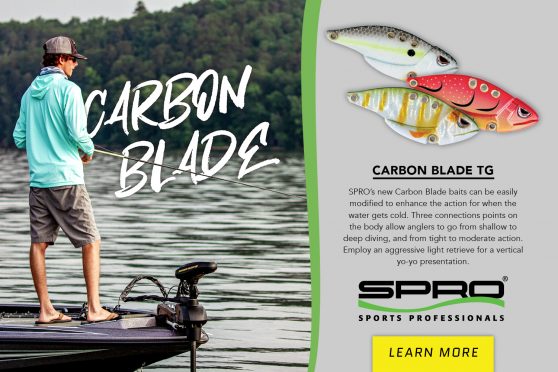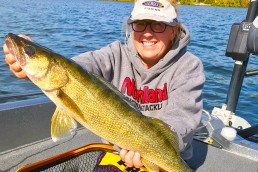‘Deer Hunting’ for Walleyes
SHARE THIS POST
 Scouting for fall walleyes is akin to selecting hunting sites for deer, says Brian Brosdahl.
Scouting for fall walleyes is akin to selecting hunting sites for deer, says Brian Brosdahl.
At summer’s end, with winter fast approaching, walleyes will gorge on minnows that inhabit the lake. In northern Minnesota, some of the primary minnow varieties that walleyes prey upon are young-of-the-year perch, ciscoes and shiners, to name a few. Finding out where the bait lives in the lake is vital to a successful day of walleye fishing.
As vegetation dies off in fall, the minnows unwillingly leave. Some form schools that roam around in mid-depth basins. Sometimes, you will find surviving weeds and they will be flush with minnows. After a hot summer like this past one, and with lower water tables, most minnows will likely be basin-bound.
Here’s where an angler’s detective work pays off. Before I wet a fishing line, I cruise basin structures with my Humminbird Helix 12 GPS G4. I follow the contour lines on my LakeMaster map on my graph. Using Mega Side Imaging, and Down Imaging sonar in concert allows me to spot potential walleye spots where there is a high concentration of baitfish. I will hit multiple spots, mark fish and baitfish, and go back and fish these spots after I check out a few areas. If I am really on the hunt, I will check out a couple dozen spots before I even start to fish.
Walleye depth can vary drastically in fall depending on turnover, water temps and wave action. Some anglers will have a great day fishing in 30-plus feet of water, while others will catch them in 8 feet on the edge of a weed line or channel—on the same body of water!
Why do I graph so much before dropping a fishing line? It stems from deer hunting—you don’t put a deer stand in the first tree that you see. You walk the whole woods and look for deer trails, deer scrapes, deer rubs, access to food and water and a good view from a high spot in a high-traffic area. Don’t forget to look for other deer stands; there might already be one nearby. I look for the perfect deer stand for walleyes—that spot that is loaded with walleyes and re-loads after you catch what is there. There are many places like this. Every body of water has spot-on-the-spot locations where walleyes swim through.
Are you enjoying this post?
You can be among the first to get the latest info on where to go, what to use and how to use it!
Some sure-fire spots that I have found are steep breaks that face the main basin of a lake, just off a weed bed. As you study the contours on your LakeMaster map and features on your sonar, you will notice little areas that stand out: saddles, points, stairsteps with rocks spilling down the side, sunken timber from the old logging days, etc.
Walleyes like feeding along a steep break in fall; it allows them to corner a school of bait against the drop-off instead of chasing them out in the open. Running baitfish into the wall (steep break) leads to confusion in the school. When a school temporarily breaks up, confused minnows go in every direction, then pause, becoming sitting ducks. Walleyes exert less energy chasing them.
My Aqua-Vu HD 7 underwater camera goes with me in my search. I like to see exactly what walleyes are holding on. I just want to double check that I am not fishing through rough fish like large suckers instead of walleyes!
For more helpful information on fall fishing, turn to the fall issues of MidWest Outdoors, available by subscribing on our website.
MWO
SHARE THIS POST
You may also like...
Nothing found.
Did you enjoy this post?
You can be among the first to get the latest info on where to go, what to use and how to use it!
Brian 'Bro' Brosdahl
Outdoor communicator Brian “Bro” Brosdahl lives in northern Minnesota. He is a walleye guide in the Cass Lake, Leech Lake and Lake Winnibigoshish areas. He is sponsored by Northland Fishing Tackle, Frabill/Plano, Aqua-Vu, Humminbird/Minn Kota, St. Croix Rods, Ranger Boats, and Evinrude. Guide inquiries: brosguideservice.com. Follow on social media.
